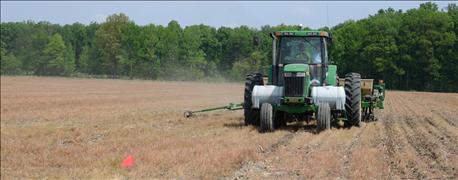
Perhaps one of the biggest factors that causes some farmers to hesitate about growing cover crops is whether they will be able to kill them effectively in the spring after they have served their purpose. The one that usually jumps to the top of the list for making people nervous is annual ryegrass.
Veteran no-till and cover crop growers who use annual ryegrass say the fear factor has long disappeared for them. Roger Wenning, Greensburg, says it’s a matter of paying attention to details, not skimping on rates, and following the advice of people who have figured out how to kill it successfully.

READY FOR PLANTING: Roger Wenning’s son, Nick, plants into a cover crop mix burned down successfully ahead of planting. He’s planting with a twin-row Great Plains planter.
Wenning sometimes uses annual ryegrass, but he also includes several other cover corps in his system. He often seeds three to four-way mixtures, or even more elaborate ones, depending on what he is trying to accomplish.
Recently, the Purdue University Extension weed control team gave their recommendations for terminating annual ryegrass in the first edition of the Purdue Pest & Crop Newsletter for 2016. The team includes Bill Johnson, Travis Legleiter and Purdue weed researcher Bryan Young. The information is also spelled out in a publication: Terminating cover crops: Successful annual ryegrass termination with herbicides. It is publication WS-52-W.
Here are four primary steps gleaned from the publication and from farmer experience:
1. Think through herbicide application timing carefully
The goal is to terminate the crop before it goes to seed. Seeds produced could cause problems in control in future years. Usually the plant goes to seed in early May in Indiana. Three things to concentrate on in terms of timing are: (1) Make sure field soil moisture conditions allow for equipment to enter the field and make the application pass properly; (2) Look for a period where air temperatures will remain above 45 degrees consistently for three to five days; and (3)
Spray before annual ryegrass reaches 8 inches tall.
2. Pick herbicides and rates that will be effective
The Purdue team, based on their research, recommend using at least 1.25 pounds of active ingredient of glyphosate per acre. That would be 36 fluid ounces of roundup Power Max per acre. If conditions are less than ideal, the weed scientists prefer 2.5 pounds of active ingredient per acre. In research trials at Purdue, adding 1 ounce per acre of Sharpen with 1.25 pounds of glyphosate gave the most consistent results at all application timings. Adding 2,4-D, dicamba and Basis Blend didn’t increase or decrease performance compared to glyphosate alone. However, adding herbicides like atrazine or metribuzin sometimes resulted in antagonism of glyphosate and failed to terminate annual ryegrass.
3. Select adjuvants to add carefully
Use only adjuvants listen on manufacturer’s labels, the trio says. For glyphosate it’s always recommended to use ammonium sulfate to condition hard water. Some use citric acid instead, but it doesn’t have the nitrogen source that helps glyphosate work more effectively.
4. A farmer tip- spray only during mid-day
Wenning and other farmers have reported that they have best luck spraying applications to terminate cover crops in the spring in the middle of the day. Applications made after mid-afternoon don’t tend to be as effective because the plants begin to shut down for the day, and aren’t moving materials throughout the plant as quickly.
About the Author(s)
You May Also Like




